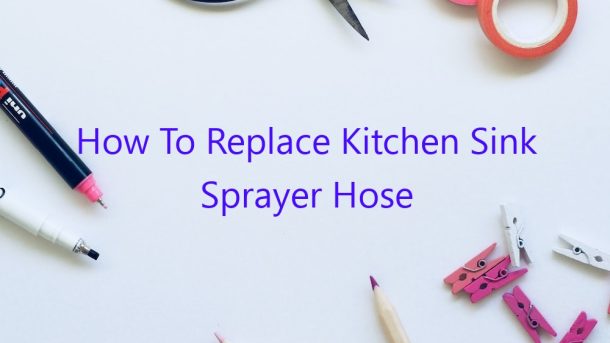A kitchen sink sprayer hose is a critical piece of equipment in any kitchen. It allows you to easily rinse dishes and clean the sink. If the hose becomes clogged or damaged, it can be difficult to clean the kitchen properly. Fortunately, replacing a kitchen sink sprayer hose is a relatively simple task.
The first step is to determine what type of hose you need. There are two main types of kitchen sink sprayer hoses – compression and threaded. Compression hoses are attached to the faucet with compression fittings, while threaded hoses are attached with threaded fittings. If you are not sure which type of hose you need, consult the owner’s manual for your faucet.
Once you have determined the type of hose you need, the next step is to remove the old hose. This can vary depending on the type of hose you have, but typically it is done by twisting the hose counterclockwise until it comes loose.
Once the old hose is removed, the new hose can be attached. Again, this will vary depending on the type of hose, but typically it is done by twisting the hose clockwise until it is tight.
Once the hose is attached, test the sprayer to make sure it is working properly. If it is not, consult the owner’s manual for your faucet for troubleshooting tips.
That’s all there is to it! Replacing a kitchen sink sprayer hose is a simple task that anyone can do.
Contents [hide]
How do you remove a sink sprayer hose?
Removing a sink sprayer hose can be a bit daunting, but it’s not too difficult. The first step is to identify the hose’s connector. It will most likely be a plastic connector that is press-fit into the sink. You can use a flathead screwdriver to pry the connector loose. Once the connector is loose, you can pull the hose out of the sink. If the connector is stuck, you can use a pliers to grip the connector and pull it out.
How do you replace a spray nozzle on a kitchen sink?
Replacing a kitchen sink spray nozzle is a relatively simple task that can be accomplished in a few minutes. The most important thing to remember is to select the correct replacement nozzle for your sink.
The first step is to remove the old nozzle. This can be done by unscrewing it from the faucet. Once the nozzle is removed, inspect it for any damage. If the nozzle is cracked or damaged, it should be replaced.
Next, select the replacement nozzle that is the correct size and type for your sink. There are several different types of nozzles available, so be sure to choose the one that is compatible with your faucet.
The replacement nozzle can be attached to the faucet in the same way that the old nozzle was removed. Simply screw it into place and tighten it until it is secure.
Testing the new nozzle is a simple process. Turn on the water and allow it to run for a few seconds. Then, test the spray by pointing it at a sink or a piece of paper. The spray should be strong and consistent.
If the spray is not working correctly, loosen the nozzle and adjust it until the spray is satisfactory. Be sure to tighten the nozzle again when finished.
Replacing a kitchen sink spray nozzle is a quick and easy task that can be completed in just a few minutes. By following these simple steps, you can ensure that your sink is spraying water correctly.
How do you install a sink sprayer hose?
Installing a sink sprayer hose is a relatively simple task that can be completed in a few minutes. The first step is to remove the old hose, if present. This can usually be done by twisting it off or by using a pair of pliers. The new hose can then be attached by twisting it on or by using a pair of pliers. Be sure to tighten it securely to prevent leaks.
Do you have to turn water off to replace sink sprayer?
When it comes time to replace a sink sprayer, some people may wonder if they have to turn the water off. The answer is no – you do not have to turn the water off to replace a sink sprayer.
Replacing a sink sprayer is a relatively easy task. All you need is a screwdriver and a new sink sprayer. To replace the sprayer, first remove the old one by unscrewing it from the faucet. Then screw on the new one and tighten it with the screwdriver.
If you are not comfortable replacing the sink sprayer yourself, you can always call a plumber to do it for you. However, it is a job that most people can do on their own with a little bit of instruction.
So, the next time you need to replace your sink sprayer, don’t worry – you don’t have to turn the water off. Just follow these simple steps and you will be up and running in no time.
How do you stop a sink sprayer from leaking?
A sink sprayer can be a convenient addition to a kitchen sink, but if it starts to leak, it can become a major nuisance. Fortunately, there are a few things you can do to stop a sink sprayer from leaking.
The most common cause of a sink sprayer leak is a worn-out washer. If this is the problem, you can usually fix it by replacing the washer. To do this, first remove the sprayer head from the faucet. Then, use a wrench to remove the nut that holds the washer in place. Remove the washer and replace it with a new one. Be sure to use the same size and type of washer as the one you removed. Reattach the sprayer head and test it to see if the leak has been fixed.
If the washer is not the problem, the next thing to check is the O-ring. The O-ring is a rubber ring that seals the connection between the sprayer head and the faucet. If the O-ring is damaged or worn out, it can cause a leak. To replace the O-ring, first remove the sprayer head from the faucet. Remove the O-ring and replace it with a new one. Reattach the sprayer head and test it to see if the leak has been fixed.
If neither the washer nor the O-ring is the problem, the next thing to check is the connection between the sprayer head and the faucet. If the connection is loose, it can cause a leak. To fix the connection, tighten the screw that holds the sprayer head in place.
If none of these solutions fixes the leak, the last thing to check is the hose. If the hose is damaged or worn out, it can cause a leak. To replace the hose, first remove the sprayer head from the faucet. Remove the hose and replace it with a new one. Reattach the sprayer head and test it to see if the leak has been fixed.
How do you remove a Moen sprayer hose?
Removing a Moen sprayer hose is a relatively simple process. You will need a wrench to remove the hose, and you may also need to purchase a new sprayer hose if it is damaged.
To remove the hose, first locate the wrench that is included with your Moen faucet. If you do not have the wrench, you can purchase one at most hardware stores. Loosen the nut on the end of the hose using the wrench. Once the nut is loosened, pull the hose off of the faucet.
If the hose is damaged, you will need to purchase a new one. To install the new hose, follow the same steps as above, but make sure to tighten the nut securely.
Are sink sprayer hoses Universal?
Are sink sprayer hoses universal? It seems that they should be, as the name suggests, but in practice this is not always the case. There are a few factors to consider when looking for a sprayer hose that will work with your sink.
The first consideration is the diameter of the hose. Most sink sprayers use a hose with a diameter of 1/2 inch, but there are a few exceptions. If your sink has a particularly large opening, you may need to find a sprayer hose with a larger diameter.
The next consideration is the length of the hose. Many sink sprayers come with a hose that is about 6 feet long, but if your sink is further from the faucet than average, you may need a longer hose.
Finally, you will need to check the connection type. Most sink sprayers use a threaded connection, but there are a few that use a push-fit connection. If your sink sprayer uses a different connection type, you will need to find a hose that matches.
With those factors in mind, it is usually easy to find a sink sprayer hose that will work with your sink. However, if you are having trouble finding one that meets your needs, you can always contact the manufacturer or a plumbing supplier for assistance.




